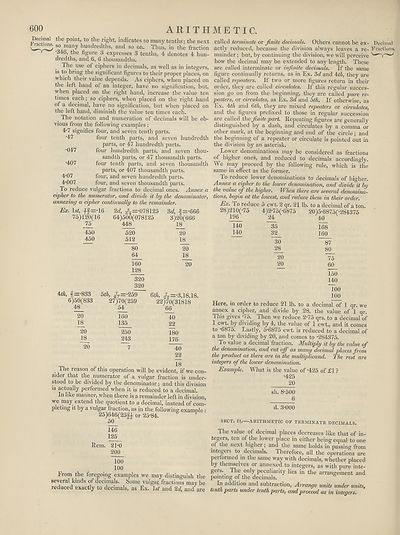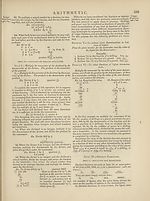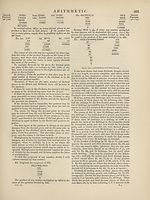Encyclopaedia Britannica > Volume 3, Anatomy-Astronomy
(608) Page 600
Download files
Complete book:
Individual page:
Thumbnail gallery: Grid view | List view

600
ARITHMETIC.
Decimal the point, to the right, indicates so many tenths; the next
iM^actions. so many hundredths, and so on. Thus, in the fraction
-346, the figure 3 expresses 3 tenths, 4 denotes 4 hun¬
dredths, and 6, 6 thousandths.
. Hle .use °f ciphers in decimals, as well as in integers,
is to bring the significant figures to their proper places, on
which their value depends. As ciphers, when placed on
the left hand of an integer, have no signification, but,
when placed on the right hand, increase the value ten
times each; so ciphers, when placed on the right hand
of a decimal, have no signification, but when placed on
the left hand, diminish the value ten times each.
_ The notation and numeration of decimals will be ob¬
vious from the following examples :
4*7 signifies four, and seven tenth parts.
•47 four tenth parts, and seven hundredth
parts, or 47 hundredth parts,
four hundredth parts, and seven thou¬
sandth parts, or 47 thousandth parts,
four tenth parts, and seven thousandth
parts, or 407 thousandth parts,
four, and seven hundredth parts,
four, and seven thousandth parts.
To reduce vulgar fractions to decimal ones. Annex a
cipher to the numerator, and divide it by the denominator,
annexing a cipher continually to the remainder.
Ex. 1st, ff=T6 2d, ^=-078125 3d, |=*666
75)120(16 64)500(078125 3)20(666
75 448 18
•047
•407
4-07
4-007
450
450
520
512
80
64
160
128
320
320
4th, f=-833
6)50(833
48
20
18
20
18
~20
5th, /t=-259
27)70(259
54
160
135
250
243
20
18
"20
18
20
6th, ^=-3,18,18.
22)70(31818
66
^~0
22
180
176
40
22
18
The reason of this operation will be evident, if we con-
sider that the numerator of a vulgar fraction is under-
stood to be divided by the denominator; and this division
is actually performed when it is reduced to a decimal.
In like manner, when there is a remainder left in division,
we may extend the quotient to a decimal, instead of com¬
pleting it by a vulgar fraction, as in the following example :
25)646(25|4 or 25-84.
50
Rem.
146
125
21-0
200
100
100
called terminate or Jinite decimals. Others cannot be ex- Decimal
actly reduced, because the division always leaves a re- Fractions,
mainder; but, by continuing the division, we will perceive
how the decimal may be extended to any length. These
are called interminate or infinite decimals. If the same
figure continually returns, as in Ex. 3d and 4th, they are
called repeaters. If two or more figures return in their
order, they are called circulates. If this regular succes¬
sion go on from the beginning, they are called pure re¬
pealers, or circulates, as Ex. 3d and 5th. If otherwise, as
Ex. 4th and 6th, they are mixed repeaters or circulates,
and the figures prefixed to those in regular succession
are called t\\e Jinite part. Repeating figures are generally
distinguished by a dash, and circulates by a comma or
other mark, at the beginning and end of the circle; and
the beginning of a repeater or circulate is pointed out in
the division by an asterisk.
Lower denominations may be considered as fractions
of higher ones, and reduced to decimals accordingly.
We may proceed by the following rule, which is the
same in effect as the former.
To reduce lower denominations to decimals of higher.
Annex a cipher to the lower denomination, and divide it by
the value of the higher. When there are several denomina¬
tions, begin at the lowest, and reduce them in their order.
Ex. To reduce 5 cwt. 2 qr. 21 lb. to a decimal of a ton.
28)210(-75 4)2-75(-6875 20)5-6875(-284375
196
140
140
24_
~35
32
40
168
160
30
28
20
20
87
80
75
60
150
140
100
100
Here, in order to reduce 21 lb. to a decimal of 1 qr. we
annex a cipher, and divide by 28, the value of 1 qr.
This gives -75. Then we reduce 2-75 qrs. to a decimal of
1 cwt. by dividing by 4, the value of 1 cwt., and it comes
to *6875. Las tty, 5*6875 cwt. is reduced to a decimal of
a ton by dividing by 20, and comes to -284375.
To value a decimal fraction. Multiply it by the value of
the denomination, and cut off as many decimal places from
the product as there are in the multiplicand. The rest are
integers of the lower denomination.
Example. What is the value of -425 of £1 ^
•425
20
sh. 8-500
6
d. 3-000
SECT. II.—ARITHMETIC OF TERMINATE DECIMALS.
The value of decimal places decreases like that of in¬
tegers, ten of the lower place in either being equal to one
of the next higher; and the same holds in passing from
integers to. decimals. Therefore, all the operations are
performed in the same way with decimals, whether placed
by themselves or annexed to integers, as with pure inte¬
gers. The only peculiarity lies in the arrangement and
P* Or t.np rlppimcilc
T7 _ *1. c • , sers- Ane only pecuhai
from the foregoing examples we may distinguish the pointing of the decimals.
several kinds of decimals. Some vulgar fractions may be In addition and subtraction, Arrange unit* under units
reduced exactly to decimals, as Ex. 1st and 2d, and are tenth parts under tenth parts, and proceed as in integers. '
ARITHMETIC.
Decimal the point, to the right, indicates so many tenths; the next
iM^actions. so many hundredths, and so on. Thus, in the fraction
-346, the figure 3 expresses 3 tenths, 4 denotes 4 hun¬
dredths, and 6, 6 thousandths.
. Hle .use °f ciphers in decimals, as well as in integers,
is to bring the significant figures to their proper places, on
which their value depends. As ciphers, when placed on
the left hand of an integer, have no signification, but,
when placed on the right hand, increase the value ten
times each; so ciphers, when placed on the right hand
of a decimal, have no signification, but when placed on
the left hand, diminish the value ten times each.
_ The notation and numeration of decimals will be ob¬
vious from the following examples :
4*7 signifies four, and seven tenth parts.
•47 four tenth parts, and seven hundredth
parts, or 47 hundredth parts,
four hundredth parts, and seven thou¬
sandth parts, or 47 thousandth parts,
four tenth parts, and seven thousandth
parts, or 407 thousandth parts,
four, and seven hundredth parts,
four, and seven thousandth parts.
To reduce vulgar fractions to decimal ones. Annex a
cipher to the numerator, and divide it by the denominator,
annexing a cipher continually to the remainder.
Ex. 1st, ff=T6 2d, ^=-078125 3d, |=*666
75)120(16 64)500(078125 3)20(666
75 448 18
•047
•407
4-07
4-007
450
450
520
512
80
64
160
128
320
320
4th, f=-833
6)50(833
48
20
18
20
18
~20
5th, /t=-259
27)70(259
54
160
135
250
243
20
18
"20
18
20
6th, ^=-3,18,18.
22)70(31818
66
^~0
22
180
176
40
22
18
The reason of this operation will be evident, if we con-
sider that the numerator of a vulgar fraction is under-
stood to be divided by the denominator; and this division
is actually performed when it is reduced to a decimal.
In like manner, when there is a remainder left in division,
we may extend the quotient to a decimal, instead of com¬
pleting it by a vulgar fraction, as in the following example :
25)646(25|4 or 25-84.
50
Rem.
146
125
21-0
200
100
100
called terminate or Jinite decimals. Others cannot be ex- Decimal
actly reduced, because the division always leaves a re- Fractions,
mainder; but, by continuing the division, we will perceive
how the decimal may be extended to any length. These
are called interminate or infinite decimals. If the same
figure continually returns, as in Ex. 3d and 4th, they are
called repeaters. If two or more figures return in their
order, they are called circulates. If this regular succes¬
sion go on from the beginning, they are called pure re¬
pealers, or circulates, as Ex. 3d and 5th. If otherwise, as
Ex. 4th and 6th, they are mixed repeaters or circulates,
and the figures prefixed to those in regular succession
are called t\\e Jinite part. Repeating figures are generally
distinguished by a dash, and circulates by a comma or
other mark, at the beginning and end of the circle; and
the beginning of a repeater or circulate is pointed out in
the division by an asterisk.
Lower denominations may be considered as fractions
of higher ones, and reduced to decimals accordingly.
We may proceed by the following rule, which is the
same in effect as the former.
To reduce lower denominations to decimals of higher.
Annex a cipher to the lower denomination, and divide it by
the value of the higher. When there are several denomina¬
tions, begin at the lowest, and reduce them in their order.
Ex. To reduce 5 cwt. 2 qr. 21 lb. to a decimal of a ton.
28)210(-75 4)2-75(-6875 20)5-6875(-284375
196
140
140
24_
~35
32
40
168
160
30
28
20
20
87
80
75
60
150
140
100
100
Here, in order to reduce 21 lb. to a decimal of 1 qr. we
annex a cipher, and divide by 28, the value of 1 qr.
This gives -75. Then we reduce 2-75 qrs. to a decimal of
1 cwt. by dividing by 4, the value of 1 cwt., and it comes
to *6875. Las tty, 5*6875 cwt. is reduced to a decimal of
a ton by dividing by 20, and comes to -284375.
To value a decimal fraction. Multiply it by the value of
the denomination, and cut off as many decimal places from
the product as there are in the multiplicand. The rest are
integers of the lower denomination.
Example. What is the value of -425 of £1 ^
•425
20
sh. 8-500
6
d. 3-000
SECT. II.—ARITHMETIC OF TERMINATE DECIMALS.
The value of decimal places decreases like that of in¬
tegers, ten of the lower place in either being equal to one
of the next higher; and the same holds in passing from
integers to. decimals. Therefore, all the operations are
performed in the same way with decimals, whether placed
by themselves or annexed to integers, as with pure inte¬
gers. The only peculiarity lies in the arrangement and
P* Or t.np rlppimcilc
T7 _ *1. c • , sers- Ane only pecuhai
from the foregoing examples we may distinguish the pointing of the decimals.
several kinds of decimals. Some vulgar fractions may be In addition and subtraction, Arrange unit* under units
reduced exactly to decimals, as Ex. 1st and 2d, and are tenth parts under tenth parts, and proceed as in integers. '
Set display mode to:
![]() Universal Viewer |
Universal Viewer | ![]() Mirador |
Large image | Transcription
Mirador |
Large image | Transcription
Images and transcriptions on this page, including medium image downloads, may be used under the Creative Commons Attribution 4.0 International Licence unless otherwise stated. ![]()
| Encyclopaedia Britannica > Encyclopaedia Britannica > Volume 3, Anatomy-Astronomy > (608) Page 600 |
|---|
| Permanent URL | https://digital.nls.uk/193765252 |
|---|
| Attribution and copyright: |
|
|---|---|
| Shelfmark | EB.16 |
|---|---|
| Description | Ten editions of 'Encyclopaedia Britannica', issued from 1768-1903, in 231 volumes. Originally issued in 100 weekly parts (3 volumes) between 1768 and 1771 by publishers: Colin Macfarquhar and Andrew Bell (Edinburgh); editor: William Smellie: engraver: Andrew Bell. Expanded editions in the 19th century featured more volumes and contributions from leading experts in their fields. Managed and published in Edinburgh up to the 9th edition (25 volumes, from 1875-1889); the 10th edition (1902-1903) re-issued the 9th edition, with 11 supplementary volumes. |
|---|---|
| Additional NLS resources: |
|

